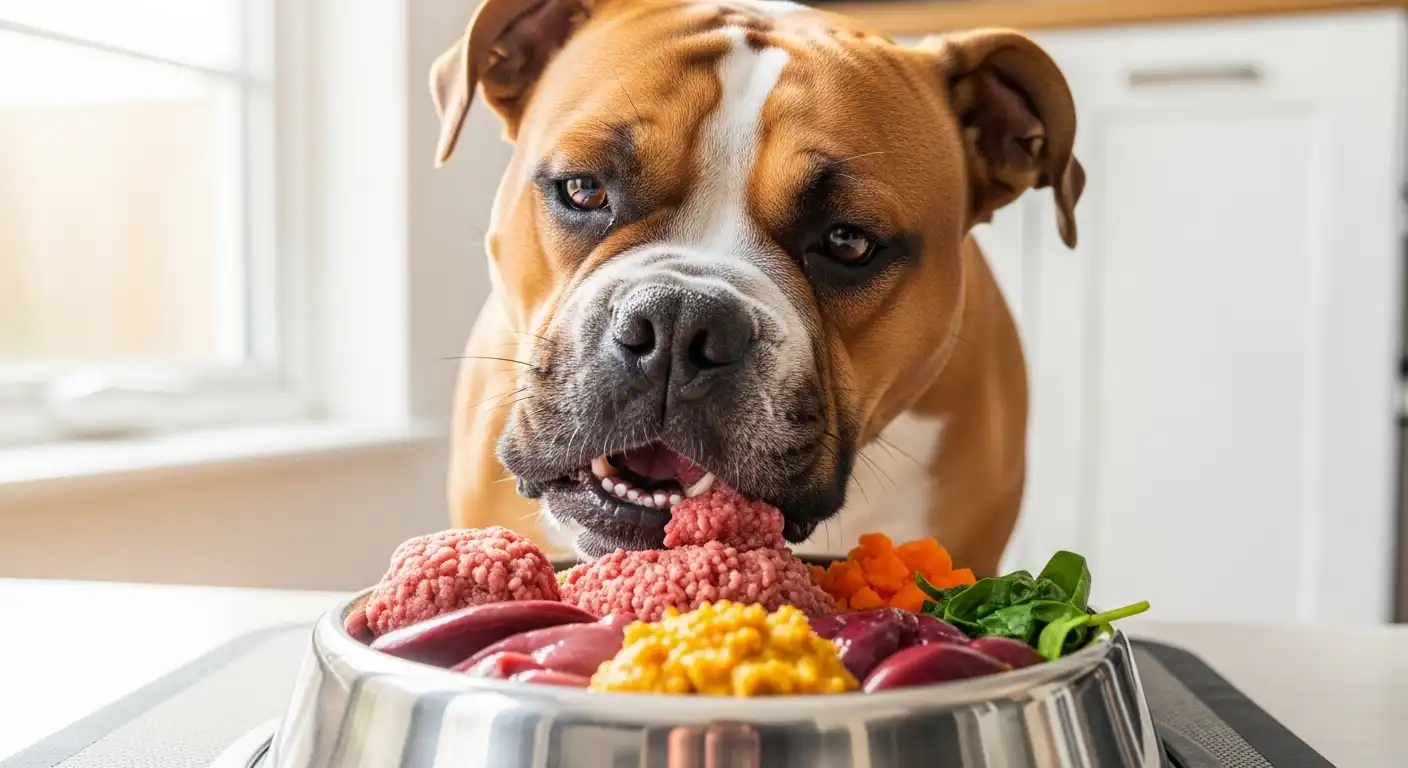The food you choose for your Continental Bulldog shapes their health, energy, and even lifespan. Among owners in 2025, the biggest question is whether raw feeding or kibble diets are the better choice. The truth is more complex than one option being “better” than the other. This guide breaks down everything you need to know, from nutritional science to budget considerations, so you can choose the right path for your dog.
Why Diet Matters for Continental Bulldogs
Continental Bulldogs are compact, muscular, and affectionate. While generally healthier than other bulldog breeds, they are prone to weight gain, digestive sensitivity, and skin issues. This makes diet more than just a preference — it’s a cornerstone of their well-being. Poor diet can lead to obesity, joint strain, or worsening allergies. A tailored feeding plan can prevent many health problems before they even start.

What Is a Raw Diet?
A raw diet, sometimes called BARF (Biologically Appropriate Raw Food), is built around fresh meat, bones, vegetables, and supplements. Some owners prepare it at home, while others buy commercially prepared raw patties or freeze-dried raw blends. In 2025, the raw feeding market has grown with improved safety standards, making it easier for everyday owners to try.
Pros of Raw Feeding
- High protein supports lean muscle maintenance.
- Shinier coat and fewer skin flare-ups, especially in allergy-prone Bulldogs.
- Smaller, firmer stools due to better nutrient absorption.
- Moisture-rich meals reduce dehydration risks.
Cons of Raw Feeding
- Higher cost than kibble, especially for large dogs.
- Storage challenges — requires freezer space and careful thawing.
- Risk of bacteria (salmonella, E. coli) if food safety is ignored.
- Requires careful balancing of calcium, phosphorus, and vitamins.

What Is Kibble?
Kibble is dry, shelf-stable dog food made from meat, grains, legumes, or vegetables, processed into bite-sized pieces. Modern kibble has come a long way in quality. Many brands in 2025 now emphasize grain-free, limited-ingredient, or veterinary-approved formulas tailored for dogs with sensitivities.
Pros of Kibble
- Convenient and affordable for most households.
- Consistent nutrition — meets AAFCO feeding guidelines.
- Supports dental health thanks to crunchy texture.
- Stores easily and lasts longer than raw food.
Cons of Kibble
- Lower moisture content — can contribute to dehydration.
- Some brands still use fillers or artificial preservatives.
- May worsen skin or digestive issues in sensitive Bulldogs.
- Less variety in texture and taste compared to fresh food.
What’s Trending in 2025?
Several new feeding styles have gained traction this year:
- Hybrid Diets: Mixing raw and kibble to balance cost and convenience.
- Freeze-Dried Raw: Raw nutrition with kibble-like convenience.
- Functional Kibble: Enhanced with probiotics, omega-3s, and joint support tailored to brachycephalic breeds like Bulldogs.
- Sustainable Sourcing: Ethical proteins such as insect meal and plant-forward formulas are growing in popularity.
How Raw Diets Compare to Kibble Nutritionally
| Nutrient | Raw Diet | Kibble |
| Protein | High (fresh meat, organs) | Moderate to high depending on brand |
| Fat | Variable, often high | Controlled, but sometimes too high in cheap brands |
| Fiber | Low unless vegetables added | Higher from grains/legumes |
| Moisture | 70–80% | 10–12% |
| Digestibility | High with proper balance | Moderate; fillers reduce absorption |
Budget Considerations
Feeding choices often come down to cost. On average in 2025:
- Kibble: $50–$100 per month for premium formulas.
- Raw (homemade or pre-made): $150–$350 per month, depending on dog size and protein sources.
- Hybrid feeding: Around $120–$200 per month, offering a middle ground.

Health Conditions That Influence Diet
Your Continental Bulldog’s unique health profile matters more than trends:
- Skin allergies: Raw diets or limited-ingredient kibbles may reduce flare-ups.
- Joint issues: Kibbles with glucosamine and chondroitin can support mobility.
- Digestive sensitivity: Raw can improve digestion, but balanced kibble with probiotics also works well.
- Obesity: Both raw and kibble can contribute to weight gain if portions aren’t controlled.
Transitioning Between Diets
Switching suddenly between raw and kibble can upset your dog’s stomach. Transition slowly over 7–10 days:
- Start with 75% current food, 25% new food.
- Gradually increase the proportion of new food every 2–3 days.
- Monitor stool consistency, skin, and energy levels throughout.
Sample Daily Feeding Routines
All-Kibble Diet Example
- Morning: 1.5 cups high-protein kibble with omega-3 topper
- Evening: 1.5 cups kibble with joint-support supplement
All-Raw Diet Example
- Morning: 8 oz ground turkey, spinach, bone meal
- Evening: 8 oz beef chunks, pumpkin, fish oil
Hybrid Feeding Example
- Morning: 1 cup premium kibble with freeze-dried raw topper
- Evening: 8 oz raw chicken and vegetables
Safety Tips
- Wash hands, bowls, and surfaces after raw feeding.
- Keep kibble sealed in airtight containers.
- Do not mix raw and kibble in the same bowl — different digestion speeds can cause issues.
- Schedule regular vet visits to monitor weight and nutrient levels.
Which Diet Is Best?
The best diet for your Continental Bulldog depends on your lifestyle, budget, and your dog’s specific needs. For some, kibble is the practical solution. For others, raw feeding provides visible health benefits. In 2025, many owners find success with a hybrid approach that blends convenience with freshness.
Further Reading
For an expert comparison, see PetMD’s guide on raw vs. kibble diets.

